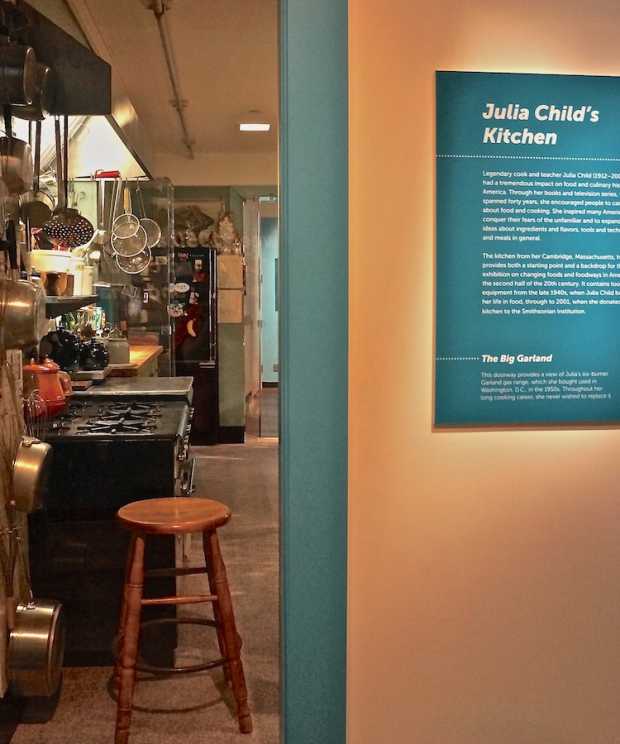Not a member yet? Sign Up!
Info
Please use real email address to activate your registration

America’s culinary queen, Julia Child (1912– 2004), had a tremendous impact on the way people view food and cooking in America. Through her books and television series, she inspired many to try new ideas about ingredients and flavors, tools and techniques, and meals in general.
Our first visit Julia Child’s Kitchen at the National Museum of American History in Washington DC last year led to disappointment as it was temporarily closed in preparation for a new and larger exhibit. We consoled ourselves by reading a post in the museum blog, 7 ways to survive while Julia Child’s kitchen is closed for 7 months

French cooking in America
Having spent a few years in Paris and studied at Le Cordon Bleu, when her husband Paul Child was stationed at the American embassy there, Julia Child introduced her knowledge of French cuisine and cooking techniques to the Americans in 1960s.
French cooking, according to the New York Times, became a passion for home cooks in the US, with the publication of the first volume of “Mastering the Art of French Cooking,” by Julia Child, Louisette Bertholle and Simone Beck, just a few months after a French Chef, René Verdon, was hired by Jacqueline Kennedy as the White House chef.

In 2001 Julia Child donated the kitchen from her Cambridge, Massachusetts home to the Smithsonian Institution. It was the same kitchen where Julia cooked for her family and friends, as well as for millions of viewers who enjoyed her three cooking shows taped in the kitchen in the 1990s.
A decade of Bon Appétit exhibition
Since Bon Appétit, an exhibition featuring Julia Child’s Kitchen first opened in 2002 almost 5 million visitors yearly came to Julia’s Kitchen at the Smithsonian, to view her tools and equipment first assembled in the late 1940s, when Julia Child began her life in food, through to 2001.
Six months after our first try, we visited the museum again. Julia Child’s Kitchen, is now the opening story of an exhibition: FOOD- Transforming the American Table 1950-2000.
Even for those who have never heard of Julia Child, the kitchen is fascinating especially if you begin your tour from a TV monitor that continuously show footage of Julia Child’s Kitchen Wisdom.
It has interchanging clips between Julia’s 40 years on television and stories from culinary celebrities such as Jacques Pepin, Martha Stewart, Emeril Lagasse, Jasper White, Alice Waters, and Thomas Keller.
The video and the companion book of the same name that we bought at the museum store contain essential techniques and recipes from Julia’s lifetime of cooking, covering soups; salads; vegetables; meats, poultry and fish; egg cookery; breads, crepes and tarts; cakes and cookies.
Marked Pegboard
A fact sheet from the museum helped us understand how Julia’s Kitchen was originally set up in Cambridge and what it now consists of.
The kitchen, measures 6 X 4.2 meters with the appliances, counters, cabinets, tools and utensils, is assembled according to its exact placement in Julia’s kitchen as of Nov. 2001, when the museum documented it before taking it apart.
During the transition from the old exhibition than began in 2002 to a new one in 2012, it took a small army of Smithsonian staff, students and volunteers to dust, vacuum, and pack more than 1200 items in the kitchen as seen in this video.
Paul and Julia arranged the pots, pans, skillets and utensils on pegboard-covered walls where Paul outlined each pot in black marker, making it simple for anyone using the kitchen to put things away properly.

In 1956 the Childs bought The Garland, a six-burner, gas commercial range manufactured in the early 1950s that Julia used until she donated the kitchen to the Smithsonian.
Warm, funny and inviting
The major difference visitors will notice with the new installation, according to the Smithsonian curators, is that they can now walk around the perimeter of the room. New viewing portals by opening the kitchen windows above the sink and countertops allow up-close-and-personal views of some of Julia's favorite tools.
Julia often used props and humor in her TV shows, some of which are on display at the Smithsonian. French bistro signs advertised the plats du jour (daily specials), some of them offering things, like a tasting of tripe, she knew her American audience would find funny and strange.
In 1976 Julia wrote about the kitchen for the Architectural Digest: "The kitchen proper was our major concern because, to us, it is the beating heart and social center of the household. Although this was our ninth kitchen, we never before had had the luxury of a large and well-proportioned room. We intended to make it both practical and beautiful, a working laboratory as well as a living and dining room."
We circled the kitchen exhibit several times, reread all the exhibit panels and felt Julia Child’s warm and inviting spirit.
---------------------------
Images: Omar Niode Foundation